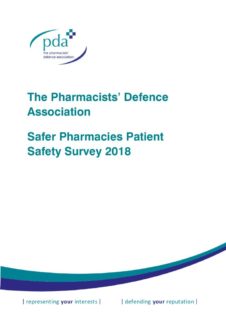The surveys revealed various trends in community pharmacy, including:
- For each patient safety question, each year, independent & smaller multiple pharmacies fared better than the large CCA multiples when grouped together (ASDA, Boots, Lloyds, Morrisons, Rowlands, Superdrug, Tesco and Well) but the responses varied between the chains. The responses by chain have also been published
- The above is true whether looking at the undesirable outcomes of the question (for example, responses which would indicate poor staffing) or the desirable outcome (for example, adequate staffing all of the time).
Several respondents also indicated in their comments that they were leaving or had recently left community pharmacy to work in a GP practice.
Alima Batchelor, Head of Policy at the PDA, said: “Patient safety has its foundations in the systems and working environments that underpin pharmacy practice. The Safer Pharmacies Charter is designed to help employers, pharmacy regulators and the government embed those foundations, which are an essential pre-requisite to patient safety. Unfortunately, the survey results show that many pharmacists report those building blocks are missing, and that in some key aspects of patient safety there has been a deterioration in their experiences over the past three years.”
After the first survey, the PDA wrote to the superintendents of each of the CCA multiples and offered to meet with them about the results.
Alima continued: “Those who are responsible for patient safety must take note – and as a profession we must collectively exercise one of the fundamental tenets of patient safety: learning from what has gone wrong. We are committed to working with others to improve patient safety in pharmacy practice. As practising pharmacists, our members are naturally interested in the safety and wellbeing of patients.”
In support of the Safer Pharmacies campaigning, the PDA will soon conduct a further patient safety survey and will report on the responses. The PDA will call on pharmacists to complete the survey and will continue to monitor the situation.
Pharmacy Sector Comparison – 2018 Survey
From the 2018 survey, the community and hospital sectors of practice could also be compared.
| Safer Pharmacies Charter Principle | Community | NHS Hospital |
| NO SELF-CHECKING | 7/49 | 27/24 |
| SAFE STAFFING | 3/72 | 5/56 |
| ACCESS TO A PHARMACIST | 48/16 | 51/20 |
| ADEQUATE REST | 9/69 | 12/57 |
| RESPECT FOR PROFESSIONAL JUDGEMENT | 10/56 | 23/27 |
| RAISING CONCERNS | 8/72 | 16/48 |
| PHYSICALLY SAFE | 21/40 | 39/21 |
The figures in the table are percentages in the format “% All of the time / % around half the time or less”, reflecting the extent to which respondents said the commitments had been met by their employer within the past six months.
Hospital Pharmacy Insights – 2018 Survey
Insights for the hospital sector included:
- For each of the principles in the Safer Pharmacies Charter, hospital pharmacy fared considerably better than community pharmacy.
- The one exception to that was the “Access to a pharmacist” principle (that a pharmacist is available wherever and whenever patients expect immediate access to face-to-face expert advice on any medicines-related matters.)
- The above points are true whether looking at the undesirable outcomes of the question (for example, responses which would indicate poor staffing) or the desirable outcome (for example, adequate staffing all of the time).
- As with community pharmacy, the results in the hospital sector are still cause for concern.
The results of each survey can be downloaded here:
2015/16
2016/17
2018
Comparison table summary for community pharmacy (2015 to 2018)
A comparison table can be downloaded here:



